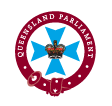-
Visit and learn
- Message from the Speaker
-
About Us
- A day in the Life of the Queensland Parliament
- The Executive Government of Queensland
- Officers of the Queensland Parliament
- The Origins of the Queensland Parliament
- The Queensland Parliament and Parliamentary Process
- Parliamentary Scrutiny via Parliamentary Committees
- The Queensland Parliament and the Financial Process
- The Queensland Parliament and the Legislative Process
- The Queensland Constitution
- The Queensland Electoral System
-
The Role of Parliament
- Separation of Powers
- Learn About Parliament
- Information For
- Visitors
- Visit the Public Gallery
- Visit our Gift Shop
- Have Your Say
- Get Involved
- Education and Learning
- History
- Heritage Collections
- Preservation of our Heritage
- Regional Sittings
- CPA Australia and Pacific Regional Conference
- Publications and Reports
- Speakers' Corner
- Opening of the 58th Parliament
- Parliamentary Annexe Reparation and Refurbishment
- Contact Us
Queensland's Parliamentary structure
Originally, the Queensland Constitution provided for a Parliament consisting of two Houses - a Legislative Council (Upper House) whose Members were appointed by the Governor and a Legislative Assembly (Lower House) comprising 26 Members who were elected to represent 16 electorates.In 1922 the Theodore Labor Government abolished the Legislative Council, thereby converting the Queensland Parliament from a bicameral arrangement (two Houses) to a unicameral (one House).
Under sections 1 and 2 of Queensland's Constitution Act 1867, legislative power is vested in the Queen and the Legislative Assembly. A 1977 amendment ensures that the Queen is a necessary component of the Parliament’s definition and that Bills passed by the Parliament have to be presented to the Governor for Royal Assent "by or in the name of the Queen". The present Parliament is composed of 93 Members each representing a single-member electorate.
The functions of the Queensland Parliament
As a representative assembly, the Queensland Parliament is responsible for a number of functions which overlap and interact.1. Form government, after a general election, it provides the State Government from the political party or coalition of parties which has obtained a majority of the seats in the Legislative Assembly.
2. Make Law, a more identifiable function concerns the passage of legislation, which, as statutes, constitute the State’s laws as well as the basis for Government activity.
3. Budget and supply, it has a financial responsibility by overseeing and granting the Government’s requested yearly appropriations of revenue and expenditure.
4. Scrutiny, it provides a forum for the scrutiny of the Executive Government’s activities through a variety of parliamentary procedures including Question Time, Adjournment Debates and Grievance Debates, Matters of Public Interest, Notices of Motion, Private Members’ Bills, Private Members' Statements, legislation debates and Parliamentary Committees.
5. Representation, it is a representative institution for all of the State’s citizens via their elected Members.
6. Debate and Grievance, the public interest of the State's citizens can be accommodated within the Parliament through parliamentary procedures such as Petitions, Matters of Public Interest, Adjournment Debates, Grievance Debates, Address-in-Reply debates or even within the debates on legislation.
Categories of membership
The Queensland Parliament presently comprises 93 Members. Since 1869, membership categories have broadened extensively. Originally, only males representing a select property class were eligible for election to the Parliament. As the State’s franchise broadened so did the categories of persons allowed to enter Parliament increase – British and naturalised males over 21 years (1905); women (1915); natives of British India (1931); British subjects who were natives of Asia and Africa (1959); First Nations peoples (1965); and adults over 18 years (1973).
Persons presently not eligible for election to the Parliament include undischarged bankrupts, prisoners, Commonwealth parliamentarians and persons convicted of certain offences under the Electoral Act 1992.
